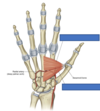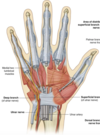A4 - Wrist & Hand Flashcards
What are the 3 bones that make up the hand?
- carpal bones 2. metacarpals 3. phalanges
Label the movements of the fingers and the bones of the hand


Which bones make up the proximal row of carpal bones?
From radial side to ulnar:
- scaphoid
- lunate
- triquetral
- pisiform
Which carpal bones make up the distal row?
From ulnar side to radial:
- hamate
- capitate
- trapezoid
- trapezium
Which of the carpal bones articulate with the radius to form the radiocarpal (wrist) joint?
- scaphoid
- lunate
- part of the triquetral
Which of the carpal bones is most commonly fractured?
What can happen in later life if this fracture is missed?
scaphoid bone
if a fracture of the scaphoid is missed, the part of the scaphoid that interacts with the radius dies
this leads to painful arthritis in later life
Label the carpal bones


What are the 4 joints within the hand?
- metacarpophalangeal joints
- proximal interphalangeal joints
- distal interphalangeal joints
- the carpometacarpal joint
What bones are involved in a ‘boxer’s fracture’?
this is a break of the 5th metacarpal bones
Which bones are involved in forming the carpometacarpal joint?
the trapezium and the first metacarpal
Label the joints of the hand


What are the following movements of the thumb?


What are the 2 types of nodes associated with osteoarthritis?
Which joints do they affect?
Herberden’s nodes affect the distal interphalangeal joints
Bouchard’s nodes affect the proximal interphalangeal joints
What are the following nodes associated with osteoarthritis?


What are the 3 main deformities of the hand associated with rheumatoid arthritis?
- Boutonniere deformity of the thumb
- ulnar deviation of metacarpophalangeal joints
- swan-neck deformity of the fingers

How does the Boutonniere deformity affect the joints in the hand?
the proximal interphalangeal joint is permanently bent towards the palm
the distal interphalangeal joint is bent away from the palm
How does the swan neck deformity affect the joints in the hand?
It causes distal interphalangeal joint to be bent towards the palm
the proximal interphalangeal joint is bent away from the palm
What is the carpal tunnel?
a space on the anterior aspect of the wrsit
the long flexor tendons of the forearm and the median nerve pass through it
What forms the roof, floor and sides of the carpal tunnel?
Roof:
transverse carpal ligament (this is the flexor retinaculum)
Floor and sides:
carpal bones
What are the 4 main structures that run through the carpal tunnel?
- median nerve
- 4 tendons of flexor digitorum profundus
- 4 tendons of flexor digitorum superficialis
- tendon of flexor pollicis longus
What structure is implicated in carpal tunnel syndrome?
the median nerve becomes compressed within the carpal tunnel
Label the components of the carpal tunnel


What are the 2 main functions of the palmar aponeurosis?
- it protects the underlying tendons
- it gives firm attachment to the skin of the palm to improve the grip
What is the apex of the triangular palmar aponeurosis continuous with?
the palmaris longus tendon




























